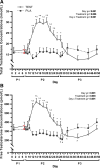Testosterone undecanoate administration prevents declines in fat-free mass but not physical performance during simulated multi-stressor military operations
- PMID: 35796614
- PMCID: PMC9359646
- DOI: 10.1152/japplphysiol.00190.2022
Testosterone undecanoate administration prevents declines in fat-free mass but not physical performance during simulated multi-stressor military operations
Abstract
Male military personnel conducting strenuous operations experience reduced testosterone concentrations, muscle mass, and physical performance. Pharmacological restoration of normal testosterone concentrations may attenuate performance decrements by mitigating muscle mass loss. Previously, administering testosterone enanthate (200 mg/wk) during 28 days of energy deficit prompted supraphysiological testosterone concentrations and lean mass gain without preventing isokinetic/isometric deterioration. Whether administering a practical dose of testosterone protects muscle and performance during strenuous operations is undetermined. The objective of this study was to test the effects of a single dose of testosterone undecanoate on body composition and military-relevant physical performance during a simulated operation. After a 7-day baseline phase (P1), 32 males (means ± SD; 77.1 ± 12.3 kg, 26.5 ± 4.4 yr) received a single dose of either testosterone undecanoate (750 mg; TEST) or placebo (PLA) before a 20-day simulated military operation (P2), followed by a 23-day recovery (P3). Assessments included body composition and physical performance at the end of each phase and circulating endocrine biomarkers throughout the study. Total and free testosterone concentrations in TEST were greater than PLA throughout most of P2 (P < 0.05), but returned to P1 values during P3. Fat-free mass (FFM) was maintained from P1 to P2 in TEST (means ± SE; 0.41 ± 0.65 kg, P = 0.53), but decreased in PLA (-1.85 ± 0.69 kg, P = 0.01) and recovered in P3. Regardless of treatment, total body mass and fat mass decreased from P1 to P2 (P < 0.05), but did not fully recover by P3. Physical performance decreased during P2 (P < 0.05) and recovered by P3, regardless of treatment. In conclusion, administering testosterone undecanoate before a simulated military operation protected FFM but did not prevent decrements in physical performance.NEW & NOTEWORTHY This study demonstrated that a single intramuscular dose of testosterone undecanoate (750 mg) administered to physically active males before a 20-day simulated, multi-stressor military operation increased circulating total and free testosterone concentrations within normal physiological ranges and spared FFM. However, testosterone administration did not attenuate decrements in physical performance across multiple measures of power, strength, anaerobic or aerobic capacity.
Keywords: energy deficit; hypogonadism; lean body mass; skeletal muscle; strength.
Conflict of interest statement
No conflicts of interest, financial or otherwise, are declared by the authors.
Figures







Similar articles
-
Bioelectrical impedance phase angle is associated with physical performance before but not after simulated multi-stressor military operations.Physiol Rep. 2023 Mar;11(6):e15649. doi: 10.14814/phy2.15649. Physiol Rep. 2023. PMID: 36949577 Free PMC article. Clinical Trial.
-
Effects of testosterone undecanoate on performance during multi-stressor military operations: A trial protocol for the Optimizing Performance for Soldiers II study.Contemp Clin Trials Commun. 2021 Jul 3;23:100819. doi: 10.1016/j.conctc.2021.100819. eCollection 2021 Sep. Contemp Clin Trials Commun. 2021. PMID: 34278044 Free PMC article.
-
Physiological and psychological effects of testosterone during severe energy deficit and recovery: A study protocol for a randomized, placebo-controlled trial for Optimizing Performance for Soldiers (OPS).Contemp Clin Trials. 2017 Jul;58:47-57. doi: 10.1016/j.cct.2017.05.001. Epub 2017 May 4. Contemp Clin Trials. 2017. PMID: 28479217 Clinical Trial.
-
Effect of Special Operations Training on Testosterone, Lean Body Mass, and Strength and the Potential for Therapeutic Testosterone Replacement: A Review of the Literature.J Spec Oper Med. 2020 Spring;20(1):94-100. doi: 10.55460/FPEQ-KDM2. J Spec Oper Med. 2020. PMID: 32203613 Review.
-
Sex differences in the physical performance, physiological, and psycho-cognitive responses to military operational stress.Eur J Sport Sci. 2022 Jan;22(1):99-111. doi: 10.1080/17461391.2021.1916082. Epub 2021 May 10. Eur J Sport Sci. 2022. PMID: 33840352 Review.
Cited by
-
Effects of testosterone enanthate on aggression, risk-taking, competition, mood, and other cognitive domains during 28 days of severe energy deprivation.Psychopharmacology (Berl). 2024 Mar;241(3):461-478. doi: 10.1007/s00213-023-06502-8. Epub 2023 Dec 1. Psychopharmacology (Berl). 2024. PMID: 38038817 Free PMC article. Clinical Trial.
-
The effect of nandrolone decanoate administration on fatigue during a volume-overload stress in male mice.Physiol Rep. 2025 May;13(9):e70334. doi: 10.14814/phy2.70334. Physiol Rep. 2025. PMID: 40341879 Free PMC article.
-
Early Life Androgen Administration Attenuates Aging Related Declines in Muscle Protein Synthesis.Med Sci Sports Exerc. 2024 Jun 1;56(6):1118-1123. doi: 10.1249/MSS.0000000000003402. Epub 2024 Feb 3. Med Sci Sports Exerc. 2024. PMID: 38376993 Free PMC article.
-
Monitoring body composition change for intervention studies with advancing 3D optical imaging technology in comparison to dual-energy X-ray absorptiometry.Am J Clin Nutr. 2023 Apr;117(4):802-813. doi: 10.1016/j.ajcnut.2023.02.006. Epub 2023 Feb 14. Am J Clin Nutr. 2023. PMID: 36796647 Free PMC article.
-
Bioelectrical impedance phase angle is associated with physical performance before but not after simulated multi-stressor military operations.Physiol Rep. 2023 Mar;11(6):e15649. doi: 10.14814/phy2.15649. Physiol Rep. 2023. PMID: 36949577 Free PMC article. Clinical Trial.
References
-
- Lieberman HR, Farina EK, Caldwell J, Williams KW, Thompson LA, Niro PJ, Grohmann KA, McClung JP. Cognitive function, stress hormones, heart rate and nutritional status during simulated captivity in military survival training. Physiol Behav 165: 86–97, 2016. doi:10.1016/j.physbeh.2016.06.037. - DOI - PubMed
Publication types
MeSH terms
Substances
Associated data
Grants and funding
LinkOut - more resources
Full Text Sources
Medical

